Abstract
The use of macro-organisms for crop protection is one of the four pillars of biocontrol. These predators or parasitoids of crop pests are used, by introduction or conservation, in fields, greenhouses and orchards in order to reduce the impact of sucking (sap-feeding) or chewing (phytophagous) insects. However, plant protection is not the only usage of these macro-organisms, and the category was recently expanded to include global usefulness for plants in Europe. Since 2012, under the provisions of Articles L. 258-1 and -2, R. 258-1 of the French Rural and Maritime fishing Code (CRPM), and Decree no. 2012-140 of 30 January 2012, the introduction of non-indigenous macro-organisms has been regulated. Using all published national regulations, organism lists and outcomes from the French Agency for Food, Environmental and Occupational Health Safety (ANSES), we have characterized these indigenous and allowed non-indigenous macro-organisms in a systemic and complete way. After first studying these regulations and their impact in 2018, we analyze here the macro-organisms involved and their implementation regarding their origins, targets and applications in crop growth and protection.
1. Introduction
It is our objective to describe more precisely all the agents of biocontrol, which are usually divided into four pillars [1] according to the regulations which govern their use in France. We are interested in biocontrol agents (BCA) [2], specifically macro-organisms, and especially non-indigenous species. These agents, which constitute one of the four pillars, are not currently managed by plant protection regulations at EU level. Macro-organisms include vertebrates and certain invertebrates in Article L. 258-1 and -2 of the French Rural and Maritime Fishing Code (CRPM). These macro-organisms (MO) are administered [3] by the competent ministries in charge of agriculture (DGALN) and ecology (MTECT). The latest legislation also provides for the latest update of authorized indigenous and non-indigenous macro-organisms [3].
Most MOs which are used for biological control or other uses are mainly invertebrates, specifically mites and insects mostly, but also including nematodes. These MOs, in particular predators or parasites, are delivered into an environment to combat crop pests. From the several strategies for biological control, the use of entomophagous species (predators) can be obtained in two ways: introduction or increase. This latter option is the preferred strategy, even if the advantage is small with regard to the use of these MOs for parasitism.
The introduction of the French national regulations for these MOs, unique in Europe, is now being studied for the whole of the EU [4] in conjunction with other European regulations [5,6,7], along with analogous regulations in certain EU countries such as Italy in 2019 [8], some areas such as European and Mediterranean Plant Protection Organization (EPPO) regions [9,10], or worldwide [11]. The introduction of these organisms into French territory requires detailed authorizations and adherence to these regulations before the MOs can be commercialized and released. The risks to human health, animal health and the environment would thus be better controlled if the regulations were standardized throughout Europe by the same requirements. In particular, the risk of these organisms becoming invasive species needs to be carefully assessed. Take the example of the Asian (or harlequin) ladybug, Harmonia axyridis Pallas, which is native to central and eastern Asia: it was introduced into America and Europe (in France in the 1980s) to control various species of aphids. Its genetic variability and rapid development give it a great ability to adapt to the various environments it colonizes. Thus, it has managed to establish itself and disperse in many countries, impacting biodiversity, the berry industry and humans alike [12]. This example of the Asian ladybug, which has become invasive and harmful, highlights some of the potential risks of biological control by MOs [13,14].
Regulations on the introduction of MOs, which are mostly species orientated but which can also be strain specific, have therefore become more stringent in recent years [15,16]. The decrees promulgated by the Ministry of Agriculture (DGALN) follow the opinions of the French Agency for Food, Environmental and Occupational Health and Safety (ANSES) [17,18], and now the conditions for submitting applications for species introductions are clearly laid out [19]. If ANSES’s opinion concludes that the strain is indigenous in the case of an application for authorization, there is no need to rule. Negative opinions from ANSES do not give rise to authorization (no order). In addition, positive opinions do not necessarily lead to an authorization order (e.g., the case of the ladybug Iberorhyzobius rondensis). Finally, the opinion of the ministry in charge of agriculture, Direction Générale de l’Alimentation (DGALN), contributes to this evaluation, validation and individual publication system, which details the management and the publication of the list of authorized macro-organisms useful for plants for introduction into the environment in France [3].
The objective of this study is to establish the most exhaustive list possible of biocontrol MOs currently or previously in use in France, including updating and building on existing work [20], while bringing together, for each of them, their characteristics, their mode of action, the pest(s) targeted, their date of marketing in France, their previous presence or not in France as well as their precise origin, where known. We also analyzed all the allowance decrees and ANSES outcomes used to qualify the territories where these MOs are released.
This study still targets indigenous and non-indigenous MOs used in the departments of continental mainland France, Corsica and the Overseas Departments and Regions (DROM), in the context of biocontrol, and highlights the related analyses in comparison to existing ones.
2. Materials and Methods
2.1. Documentary Databases
An established database, which is an Excel table, produced by D.C. Robin during a first study performed in 2018 [20], was the starting point of this updated and more complete study. This database included a list of all known biocontrol MOs released into nature or used in confined conditions in France since 2012, along with their ecological role, the species they target, their mode of action, their geographical origin, the type of crop in which their use is possible and the regulations to which they are subjected.
2.2. Bibliography
The starting point for this study was the list of MOs described by us in 2020 [20]. MOs were researched by consulting a register of ANSES opinions and supplemented by bibliographic searches. Consultation of the ACTA Biocontrol Index guides since 2019 was used to confirm these data so far as possible. In order to undertake this study, it was necessary to create a database. Existing entomological databases and bibliographical supplements were used, in particular for the dates of first use of the MOs for agricultural purposes.
Other bibliographic searches made it possible to partially complete any missing data. However, the precision and accuracy of the data vary, which has forced us to reduce the scale of precision, mainly with regard to the precise origin of the MOs (which for some organisms is somewhat uncertain) and their date of first use (due to lack of regulation). This explains some changes in the figures, as some MOs have had their dates of first use moved forward or backward depending on recent findings.
Consultation of ANSES’s register of opinions [18,21] has been maintained since 2019. These data have been brought together in a larger database to respond to the new and additional hypotheses of this study. Monitoring of the regulations concerning them has also been continued.
Compared to the previous publication, the present study retained the scientific name, class, order and the family for the full taxonomical description of the organisms in question. Likewise, the type of biological control used and when it was used, as well as the territory of origin of the MO, were retained. The prey family or families of the MOs have also been listed. Some names have also been updated, considering the recent development in their nomenclature, although the equivalent or previous names have also been kept.
The list of MOs present in France was updated using the following tools:
- -
- The ACTA Biocontrol indexes 5th edition 2021 and 6th edition 2022 (Association de Coordination Technique Agricole) have confirmed, for those listed, that they are marketed in France.
- -
- The outcomes of ANSES applications [17].
- -
- The Centre for Agriculture and Bioscience International (CABI) site gave us access to the taxonomy of macro-organisms, the state of introduction of species in the countries, their targets as well as the parasitized stage of the target by the insect [22].
- -
- The National Inventory of Natural Heritage (INPN) site has confirmed the taxonomy of organisms [23], their location and their presence.
- -
- The Fauna Europeae database indicates the presence or otherwise of the macro-organism in France [24].
- -
- The list of the European and Mediterranean Plant Protection Organization (EPPO) references the target pests, the origins of MOs and the date of their first use in the countries [25].
- -
- Orders published on Légifrance [26].
3. Results
3.1. Macro-Organisms
3.1.1. Functions of Macro-Organisms
The great majority of these MOs have been used to control insect pests of crops and to reduce the use of “insecticides”, even though other uses are increasing. The main modes of action are predation and parasitism, but other uses are beginning to appear, and some MOs have both predatory (consumption) and parasitic (egg laying) functions.
3.1.2. Secondary Functions of Macro-Organisms
Apart from these pest control uses, other uses, such as pollination, are also now described in this study. Sterile insects, whose use dates back to the 1950s and whose first authorization in mainland France dates from 2018, now appear in this updated database.
The use of MOs for the control of undesirable plants, therefore, comparable to “herbicide” uses (knowing that predation and parasitism uses are comparable to “insecticide” uses), are regularly considered; though still not authorized [20], they remain under study and under discussion.
3.1.3. Main Modes of Action of Macro-Organisms
Seven direct modes of action (MoA) were determined from the literature, providing more precision than our previous study, with some dual MoA: egg laying, bacterial infection, aspiration of contents, consumption, egg laying and consumption, penetration and bacterial infection and consumption. An indirect mode of action, the sterile insect, is also now in use.
3.1.4. Targets of the Macro-Organisms
As for the targets, in addition to their species names, their stages were specified in the database, from eggs through larvae and their stages (only stage 1 or 2), pupae, nymphs and caterpillars to adults.
3.1.5. Regulatory Developments
Since the initial French regulation of non-indigenous MOs, the only ongoing development is a similar EU concern with the introduction of exotic MOs (specified “non-indigenous” in the regulation). This possible EU regulation could supplant, replace or extend that put in place by France. The procedures for the submission and review of applications are now explicit [18].
The aim of this study is to maintain and update the most exhaustive possible and historical list of MOs used as beneficials in “mainland” France (mainland, excluding the island of Corsica). Following the initial work [20], ANSES has published a number of individual opinions since 2019, including those dedicated to non-indigenous MOs. These opinions consider the probability of establishment of the MO, the probability of dispersion of the MO, the potential risk for human and/or animal health, the potential risk for plant health, the potential for the environment and biodiversity and the effectiveness and benefits of the MO and, finally, a decision on the application for introduction [21]. It should be noted that in the particular case of sterile insects (sterilized non-indigenous strain), since the introduction of MO to ANSES in the fight against the moth Cydia pomonella, new applications against the fruit fly Bactrocera dorsalis have been accepted.
3.2. Analysis of the Development of Macro-Organisms
3.2.1. Quantitative Development
The introduction of MOs into France began in the early 20th century. A general trend can be observed: from the 1900s to the 1960s, the introduction of MOs was relatively stable, with an average of 2.14 MOs introduced per decade into French territory. In the 1970s, a slight increase was observed, with 16 MOs being introduced in this decade. However, the number of introductions soared in the 1980s and 1990s, with an average of 46.5 MOs being introduced into the environment per decade at this time. After this peak of introduction, from the 2000s, the average number of introductions of these organisms dropped to 11.5. However, a representative result cannot yet be provided for the 2020s, as the decade has just begun (Figure 1). We note, from this first figure, a very strong use of MOs from the 1980s onwards, as well as a clear reduction in the use of new MOs in the 2000s and 2010s, even if a revival is observable in the starting decade of 2020 (Figure 1).
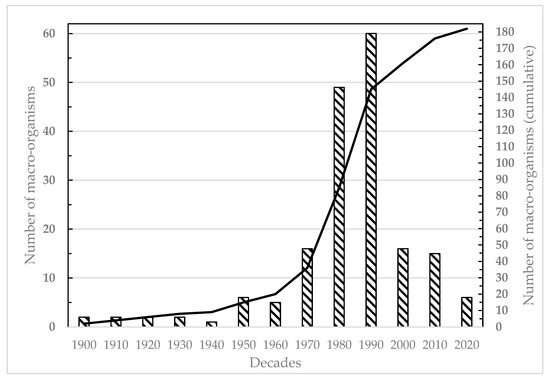
Figure 1.
Number of all MOs used (released into nature or used in confined conditions) for the first time in France (on left axis) and cumulative development (on right axis) by decade.
The total number of ANSES opinions published on these MO is currently 68, but not all of them concern the territory of mainland France; there are some for Corsica and the DROMs (French overseas territories). The average number of ANSES opinions per year has therefore been around 6–7 since 2012, which is low.
It should also be noted that a number of authorizations granted since 2015 have expired and are subject to renewal. The corresponding MOs have either been revalidated (Favorable Opinion + Order), or temporarily removed from the list (ANSES negative Opinion or no Order) except those revalidated by the Notice of 25 February 2023 [3]. This later notice informs operators and users of the list of indigenous and non-indigenous MOs useful to plants which may be marketed and introduced into the environment in France and gives details on the declaration of production and marketing of an indigenous strain of macro-organism useful for plants and request for inclusion on the lists of macro-organisms useful for plants marketed on national territory.
3.2.2. Qualitative Characteristics of MOs
A finer classification of MOs is possible according to the activity exerted by them on their target. Indeed, they can parasitize, predate or be used as pollinators of flowering plants (angiosperms and gymnosperms) or participate in the fight against insect pests by systematically releasing sterile males. Figure 2 shows the number of MOs that are parasites, predators or introduced as pollinators and sterile insects introduced into the environment in France over time and cumulatively. The general trend of the graph follows the same trend as Figure 1. This graph gives us the information that, on average, predators have been slightly more frequently introduced than parasites, pollinators and sterile insects. Indeed, about 8.6 parasites have been introduced per decade since 1900, while about 8.7 predators have been introduced per decade since 1900. In the 2010s, the trend seems have reversed with the introduction of as many predators as parasites (8). However, the overall difference remains small (about 10%).
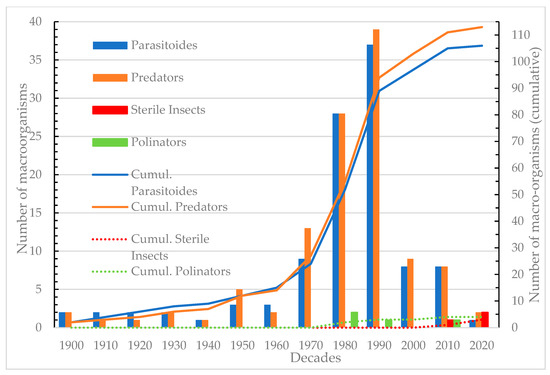
Figure 2.
Number of MOs introduced into France and their functions, parasites, predators, sterile insects and pollinators (on left axis) and cumulative development (on right axis) by decade. Parasitoids with predatory traits have been counted twice.
This variation is completed by the cumulative curve (Figure 2) which shows the intensification between 1970 and 1990 for parasitoids and predators while organized pollination began to be developed, while the sterile insect technique only began in the 2010s.
Pollinators, for their part, have only been introduced in more modest numbers (N = 4), with two pollinators introduced in the 1980s, one in the 1990s and one in the 2010s.
The exploitation of sterile insects [27] corresponding to the SIT (sterile insect technique) only began in the 2010s [28] and is now taken into account in our tables and graphs.
It should be noted that some MOs have predatory (consumption) and parasitic (egg laying) functions, and so are counted twice in the actions of Figure 2 (both numbers per decade and cumulative curve). Indeed, many parasitic species feed on the host, which can also be lethal. From 106 parasitic MOs species, 44 (41%) are involved in feeding.
Clearly, the 2020 decade has just begun, and so is under-represented in these figures since it corresponds to just 2 full years (out of 10), but it is nevertheless very active, and the recent injunctions by Mamy et al. [29] and incentives (Ecophyto II+ National Action Plan, publication of the list of MOs [3]) to develop and promote these MOs seem to us to be likely to stimulate their visibility and their promotion for better integration. At the same time, the already effective reduction of agrochemical plant protection active substances and the ongoing drastic decrease programmed [30,31] is also a powerful lever to trigger increased uptake of biocontrol mechanisms, and MOs (i.e., the fourth pillar of biocontrol) in particular.
Over time, among the three classes (Insecta, Nematoda and Arachnida), more and more orders have been introduced (Figure 3). Note the over-representation of insects. This may simply reflect that many insects are natural enemies of insect pests, or it could be due to difficulties in raising other classes in sufficient volumes to be commercially useful. Other options could be intrinsic efficiency or environmental survival of these MOs.
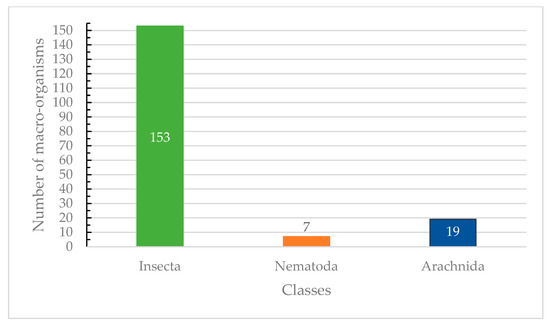
Figure 3.
MO classes involved in crop usefulness.
There are, therefore, also very strong disparities internally, both in the number of MOs per order and in the number of MOs per family in each order. Currently, 10 orders are represented (Figure 4) with very strong disparities (from 1 to more than 100).
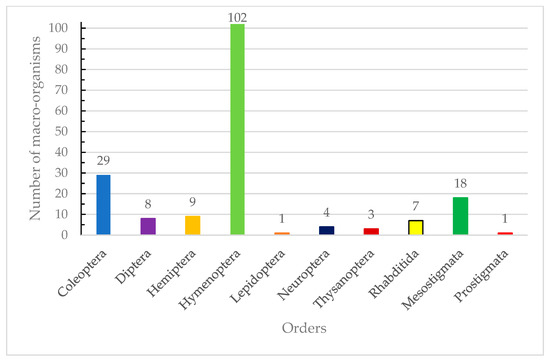
Figure 4.
Number of MOs used for different insect, nematodes and arachnid orders.
The variations of these orders into families are shown in Figure 5. There are also very strong internal disparities both in the number of families per order used (from 1 to 17) and in the number of MO species per family. Note that the column for the family Eupelmidae is now empty, following the 2023 update [3]. The colors used for families in Figure 5 are identical to the colors of the orders to which they belong in Figure 4.

Figure 5.
Number of macro-organisms per family. The colors are reproduced from Figure 4.
3.2.3. Geographical characteristics
Origin
It is also important to note that MOs do not necessarily have a single origin, and are usually “multi-origin”, with few exceptions. In addition, the precise origin of a macro-organism is often difficult to find, as the information available often only gives a wide geographical area. For example, the origin “cosmopolitan” indicates that the macro-organism comes from a “wide geographical distribution”. The origin of the MO not only makes it possible to know the current and past preferences but also to facilitate the prospecting of future MOs against the same pest in order to find alternatives either in the same regions or to diversify the MO from other regions, or to include other and, if possible, better MO candidates.
Figure 6 illustrates the origins of MOs introduced into France over time. We observe that the origins of MOs are highly variable from one decade to another. From the 1980s, MOs mostly originating from Europe, Asia and/or Africa were more abundant than those originating from other regions. These observations do not make it possible to conclude that there is a majority of original sources for introduced MOs.
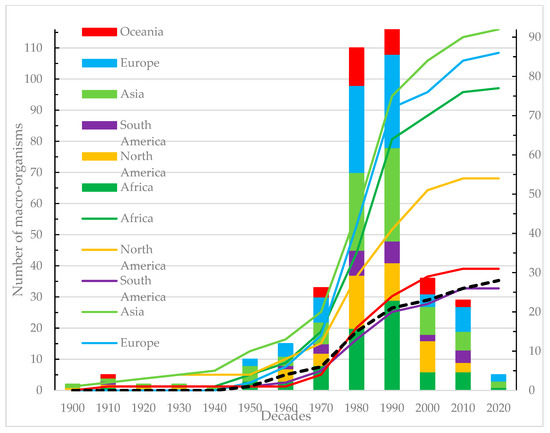
Figure 6.
Origin of all known MOs introduced into France by decade (on left axis), cumulative data (including French origin - in black dashes) and cumulative development (on right axis).
Regarding the origins by continent (Figure 6), the MOs originating from Oceania and South America are relatively few (8% and 7% respectively), but we can observe that no specific origin significantly prevails, even if the share of Asia, the most represented, corresponds to 25%. Similarly, in Figure 6, the temporal implementation is comparable between MOs from different continents.
Destination of Uses (by Decrees)
The decrees corresponding to non-indigenous MOs cover three territories: continental France, Corsica Island and the overseas islands (DROM). The decrees almost exclusively concern mainland France (continental France and Corsica Island), with a significantly greater distribution for mainland France compared to Corsica (Figure 7).
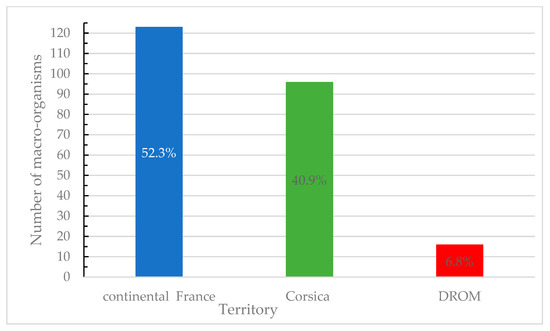
Figure 7.
Breakdown of MOs in authorization decrees in 2023.
3.3. Data
Two separate tables have been drawn up, corresponding to the two different origins. The non-indigenous MOs introduced have been listed by organism (species/strains), classes, usages (predation, parasitism, others) and with geographical origin, then divided by classes in Table 1 (insects), Table 2 (arachnids) and Table 3 (nematodes).

Table 1.
Non-indigenous insects used in France (update).

Table 2.
Non-indigenous arachnids used in France (update).

Table 3.
Non-indigenous nematodes used in France (update).
Remarkably, arachnids are only predators, while nematodes are only parasites.
The native MOs, increasingly used against crop pests, and newly authorized since 2019 (Robin, 2020), are listed in Table 4 (only an update).

Table 4.
New native macro-organism species used in France since 2019 (update).
These MOs belong to different families, but it is worth mentioning the most represented. The MO families most frequently introduced are described in Table 5 (which is an update from Robin 2020). They reflect the combined results of efficiencies, ease of production, use and adoption by users. Some families have been deleted: Hemerobiidae, Phasmarhabditidae and Rhizophagidae, while others have been added: Rhabditidae, Scelionidae, Tortricidae and Tephritidae. The rank of families by order and the number of MOs per family is detailed in Figure 6 and Figure 7.

Table 5.
Families of the most frequently introduced macro-organisms in France (update).
In parallel with the MOs used in biocontrol, the pests targeted in biological control belong to different families; it is appropriate to cite the most represented in order to understand which families are the most suitable targets for BCAs, because they are easy to combat by this method. The families of pests most targeted to be fought by biological control agents (also known as natural enemies) are Coleoptera, Lepidoptera, Diptera, Thysanoptera and Hemiptera, detailed Figure 8. Corresponding families are listed in Table 6.
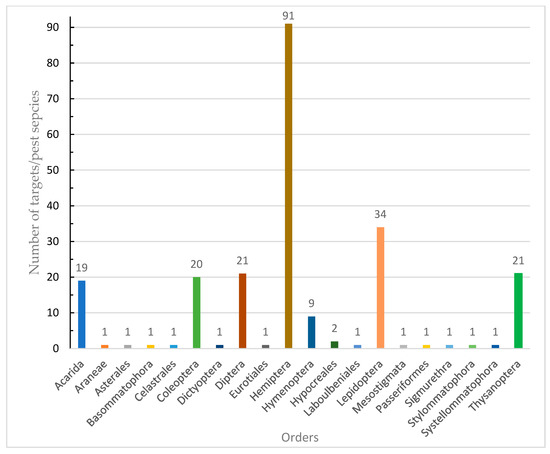
Figure 8.
Orders of the most targeted pests in France and number of MOs involved.

Table 6.
Families of the most targeted pests in France (updated).
It is remarkable, as shown in in Figure 6, that only a few orders (n = 6), representing 25% of the orders, correspond to about 90% of the total targets of the MOs.
The different targets of MOs involved in plant usages are listed in Figure 9, detailing orders, super-families and families, and fully expanded. It is important to note that, for the moment, no MOs have been implemented against nematodes/pests. Similarly, it is remarkable, in Figure 9, that only a few super-families (n = 9), representing 12% of the super-families, correspond to about 56% of the total targets of the MOs. Again, it is remarkable, in Figure 9, that only a few families (n = 11), representing less than 10% of the super-families, correspond to about 50% of the total targets of the MOs.
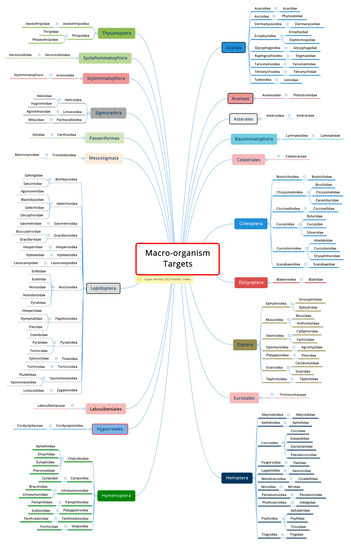
Figure 9.
Orders, super-families (where they exist) and families of the most targeted pests in France.
The data displaying Super families with number of MO in France exhibited in Figure 9 are detailed in Figure S1. Their type of action, more than the mode of action, is specified in Figure 10. A number of MOs have two functions, e.g., predatory (consumption) and parasitic (egg laying), so they are counted twice in the actions.
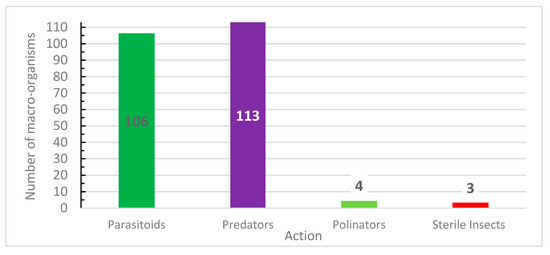
Figure 10.
Macro-organisms currently in use (actions) in France (as of 2023).
The predatory action is therefore the majority action (50%), just ahead of the parasitic action (47%), the more recent actions (in the authorization) being still very much in the minority including their use as pollinators (2%) and sterile insects (1%). Although the targets are diverse, the sometimes double or triple actions (indirect action of pollination) are mainly consumption (62%) at all stages and egg laying (parasitism) (55%), confirming Figure 9. The details are indicated in Figure 11. The possible accumulation of modes of action is a distinctive element of MOs compared to the classical protection of plants by plant protection products (PPPs), including biocontrol agents (microorganisms, semiochemicals and substances from natural origin).
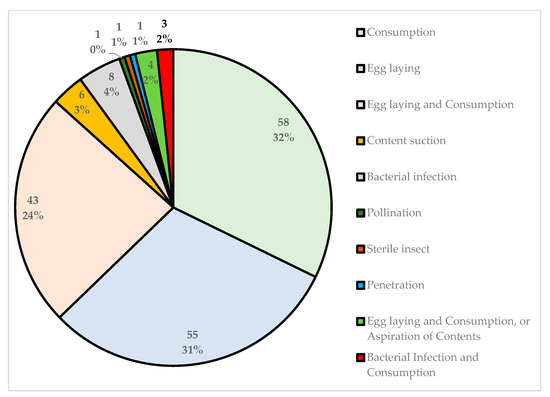
Figure 11.
Use (actions) of macro-organisms (total, detail).
The stages of the targets are, on the other hand, even more difficult to characterize, because the data are often incomplete and the specialization by stage barely exists and is effectively not studied, either for consumption or parasitism (Table 7).

Table 7.
Stages of macro-organism targets.
4. Discussion
The explosion in the use and introduction of MOs in the 1980s and 1990s is probably due to many factors, including their novelty, a growing interest in biocontrol as a component of IPM and some success [32] in the preceding decades, although the pressure against the use of agrochemicals was not as high as nowadays. Indeed, the MOs introduced were probably the easiest to raise, and the most efficient for the purpose and conferred good levels of crop protection. In addition, we can assume that pressure associated with climate change and the environmental impacts weighing on agriculture may have favored the reduction in the use of phytosanitary products by incorporating the use of natural enemies, as biocontrol is an ally of agroecological transition. Among BCAs, this crop protection approach through the use of MOs, when efficiency is also paramount, is also interesting to implement and promote for other good reasons, particularly because of the absence of chemical residues in crop production systems [33], since these residues are the main concern for consumers and applicators.
The observed drop in the number of introductions of non-indigenous MOs from the years 2000–2010 could well be linked to stricter regulations than in previous decades. These were put in place following certain incidents that appeared during the introduction of biocontrol agents that had become invasive, such as the Asian ladybug mentioned in the introduction, or the introduction of the snail Euglandina rosea as a predator of the giant African snail (Achatina fulica) in the islands of French Polynesia, which led to the disappearance of many native mollusk species there. One can therefore imagine that fewer authorizations for the entry of MOs into French territory have been authorized since these incidents. The evaluation of requests for authorizations for non-indigenous MOs useful to plants is now performed in three stages, outlined below.
Regulations are followed by a controlled release into the territory in a confined environment, then finally by the unrestricted introduction into the general environment. Despite these hurdles, however, there has been a renewed interest in the use of new MOs in the second decade of the 21st century, as proven by numerous requests for renewals and applications in progress with ANSES. It can also be assumed that, following a large number of introductions, crop pests are well controlled by these plant protection means [34,35]. Consequently, as soon as the right MO is found, the need to introduce other MOs naturally decreases for the same crop and pest target, especially since the requests have required a serious investment since 2012 (acclimatization work, application files, assessment, promotion, competition with already allowed MOs etc.). However, it should be noted that each new inundative introduction of MO does not necessarily lead to its establishment in the environment, as some MOs must be re-introduced or boosted every year.
According to the observation made concerning the development of the introduction of the various MOs in general, slightly more parasitoids were introduced [36] than predators, which could suggest a better efficiency of the mode of action of these MOs on their target pests (egg laying, bacterial infection) compared to predators that consume their prey. However, the trend is reversing, with more and more introduced predators being used (global increase in Figure 1 and Figure 2), even if the rate of new introductions per year is decreasing. Moreover, it is necessary to prove that any new MO introduced is at least as good as or better than any already in use, so as to increase their potential and their commercial success. However, this goal should not be achieved with less specificity of the targets.
The disparate observation of the origins of the MO introduced into France does not allow us to claim that the introduction of MOs from any one region of origin is more favored than any others. However, it is interesting to note that a greater proportion of MOs originating from Europe, Asia and/or Africa have been introduced into France since 1970. As these continents have hot climates, one can imagine that, due to the impact of global warming, Europe will become increasingly hospitable for them. We can also assume that they are more effective against pests in certain crops which favor the living conditions of certain pests. This suggests anticipating pests [35] and their natural enemies at the same time. From this point of view, regarding the MOs naturally present in mainland France which have been displayed in Figure 6 shows the probable limit of possible local MOs for the fight against pests.
4.1. Actions and Targets
The full panoply of individual actions implemented and potential synergies on crop pests is listed in Figure 10, which shows that these actions are potentially additive. In the two main categories of generic actions, predation and parasitism, we observe little specialization, including in the duality predation and parasitism, in terms of the targeted stages of the pest (Table 7, Figure 10), contrary to the relative host specialization as regards the target species, to guarantee effectiveness and compliance with regulations (non-intended dissemination).
4.2. Development of Macro-Organisms at the National Level
Biological control via macro-organisms, implemented at the beginning of the 20th century, continues to be a promising tool for plant protection. The introduction of MOs in France has not been constant over time, however. The growth of their use over the 20th century and the slowdown from the beginning of the 21st century of the introduction of MOs raises some questions: were the most effective and obvious MOs implemented quickly? In this case, should the hopes pinned on this pillar of biocontrol be revised downwards? If so, this would be harmful for plant protection, at a time when the BCAs of the other pillars are also stagnating (manuscript submitted).
Once again, the number of requests observed so far in the second decade of the third millennium is promising for a further acceleration in the use of MOs, perhaps due to a better understanding of their assorted modes of action and potential complications. Indeed, the number of applications (new or renewals) deposited with ANSES is increasing. France is the leading agricultural country in the European Union, so it must ensure and “lead by example” in terms of environmental and health impact in the control of its crops and agricultural production, according to Directive EC 128/2009 called “SUD”. It is also being revised to lead to a so-called “SUR” regulation in which MOs are mentioned in the “biological control” paragraph as crop protection measures and outside the scope of pesticides and EC regulation 1107/2009.
The ultimate question regarding the renewal of its authorizations arises since some authorizations have been expired for at least five years. Presumably, the petitioners whose introductions were not successful did not ask for their renewal, although no fee was requested. Indeed, quite a few renewals were granted since only five MOs were not republished by ANSES as of February 2023, although one MO (Iberorhyzobius rondensis) obtained a positive outcome.
5. Conclusions
Since 1980, the biocontrol market has been gaining ground and aims to achieve a 30% market share by 2030. By 2025 it aims to achieve a planned reduction of 50% of phytosanitary products, implying “chemicals” (Green deal, SUD then SUR) followed by the objectives of 25% of usable agricultural farmland in organic farming. These objectives imply an increased effort is being placed in research on the last pillar of biocontrol [1], i.e., macro-organisms. Since the use of PPP active substances, chemicals and BCAs combined, has decreased, MOs have become the priority candidates to control pests. The regulations for MOs, developed by France and still unique in Europe since 2012, have begun to create a framework for the introduction and use of non-indigenous MOs in European member states. The regulation of non-indigenous MOs currently in place in France could evolve in the coming years to be adopted at EU level. However, this regulation has its limits: it only covers non-indigenous MOs. The actual goal in plant protection is to maximize protection of consumers and farmers against health and environmental risks during cop protection, reducing the use of phytosanitary products and their impact on humans and the environment. Introductions of MOs can contribute to this goal, as they leave no residues in the crop production process.
Progress in this field involves sharing knowledge on biocontrol solutions and raising awareness about the importance of this type of crop protection. We provide here an exhaustive analysis of the most accurate list of the non-indigenous MOs used in France, including overseas islands, to quickly find and identify all the organisms that can be used. Furthermore, this inventory provides clear, up-to-date information, and details of the MOs which have contributed to the fourth pillar of biocontrol. Ultimately, due to the rapidly rising number of invertebrate crop pests, harmonization in the regulatory oversight of the safe use of biological control agents remains crucial. As mentioned above, the use of natural enemies in insect pest management is a promising alternative to conventional insecticides, and maybe there will be other uses in the future, especially when combined with other pest control BCA strategies. Flexibility to import and release safe BCA will help to rapidly manage crop pests crossing borders and reducing the use and risk of agrochemicals [30,31]. This will enable EU countries to make a significant and coordinated step forward for a safer agriculture.
Supplementary Materials
The following supporting information can be downloaded at: https://www.mdpi.com/article/10.3390/ecologies4030031/s1, Figure S1: Super families with number of MO in France.
Author Contributions
Conceptualization, D.C.R. and P.A.M.; methodology, D.C.R. and P.A.M.; validation, P.A.M.; investigation, M.B., J.C., D.C.R. and P.A.M.; data curation, M.B., J.C., and P.A.M.; writing—original draft preparation, P.A.M.; writing—review and editing, P.A.M.; supervision, P.A.M.; project administration, P.A.M.; funding acquisition, P.A.M. All authors have read and agreed to the published version of the manuscript.
Funding
The initial work on the regulations concerning macro-organisms was launched and supported by the Ministry for Ecological Transition, via the French Biodiversity Agency (XP-BC 2017–2019). The later research was funded by the CASDAR core endowment of our institute (2017–2022 and 2022–2027).
Institutional Review Board Statement
Not applicable.
Informed Consent Statement
Not applicable.
Data Availability Statement
Not applicable.
Acknowledgments
The authors would like to thank Bénédicte Gautier and Rémy Rossin for their advice, Rania Jabeur for her comments as well as Serge Kreiter for his answers and clarifications. The authors would like to thank Trevor M. Fenning of Forest Research (UK) for providing helpful advice on the editing and writing of the manuscript.
Conflicts of Interest
The authors declare no conflict of interest.
References
- Robin, D.C.; Merlet, L.; Marchand, P.A. Regulatory aspects of the Biocontrol. In Biocontrol of plant disease. In Recent Advance and Prospects in Plant Protection, Ecosystems and Environment, Environments, Natural or Anthropogenic Pressures; ISTE-Wilez: Hoboken, NJ, USA, 2023; Chapter 1; pp. 1–17. ISBN 9781789450989. [Google Scholar] [CrossRef]
- Robin, D.C.; Marchand, P.A. Biocontrol active substances: Evolution since the entry in vigour of Reg. 1107/2009. Pest Manag. Science 2019, 75, 950–958. [Google Scholar] [CrossRef] [PubMed]
- Légifrance. Avis aux opérateurs économiques relatif à la publication de la liste des macro-organismes utiles aux végétaux autorisés pour l’introduction dans l’environnement en France. J. Off. République Française 2023, 70, 169. Available online: https://www.legifrance.gouv.fr/jorf/id/JORFTEXT000047226582 (accessed on 27 May 2023).
- European Union. Use of Biological Control Agents (Macro-Organisms) against Plant Pests—Policy Debate (4 March 2021). 2021. Available online: https://www.parlament.gv.at/PAKT/EU/XXVII/EU/05/26/EU_52680/imfname_11048480.pdf (accessed on 27 May 2023).
- European Union. Regulation (EU). 2016/429 of the European Parliament and of the Council of 9 March 2016 on transmissible animal diseases and amending and repealing certain acts in the area of animal health (‘Animal Health Law’). Off. J. Eur. Union 2016, L84, 1. Available online: https://eur-lex.europa.eu/legal-content/EN/TXT/?uri=CELEX:32016R0429 (accessed on 27 May 2023).
- European Union. Commission Delegated Regulation (EU) 2020/692 of 30 January 2020 supplementing Regulation (EU) 2016/429 of the European Parliament and of the Council as regards rules for entry into the Union, and the movement and handling after entry of consignments of certain animals, germinal products and products of animal origin. Off. J. Eur. Union 2020, L174, 379. Available online: https://eur-lex.europa.eu/legal-content/EN/TXT/?uri=CELEX%3A32020R0692 (accessed on 27 May 2023).
- European Union. Council Decision (EU) 2021/1102 of 28 June 2021 requesting the Commission to submit a study on the Union’s situation and options regarding the introduction, evaluation, production, marketing and use of invertebrate biological control agents within the territory of the Union and a proposal, if appropriate in view of the outcomes of the study. Off. J. Eur. Union 2021, L238, 81. Available online: https://eur-lex.europa.eu/legal-content/EN/TXT/?uri=CELEX%3A32021D1102 (accessed on 27 May 2023).
- Regolamento Recante Ulteriori Modifiche Dell’articolo 12 del Decreto del Presidente della Repubblica 8 Settembre 1997, n. 357, Concernente Attuazione. 2019. Available online: http://www.edizionieuropee.it/law/html/213/zn5_06_094.html (accessed on 25 April 2023).
- Bilger, F. Safe use of invertebrate macro-organisms for biological control in the EPPO region. Bull. OEPP/EPPO Bull. 2001, 31, 405–410. [Google Scholar] [CrossRef]
- Barratt, B.I.P.; Moran, V.C.; Bigler, F.; van Lenteren, J.C. The status of biological control and recommendations for improving uptake for the future. BioControl 2018, 63, 155–167. [Google Scholar] [CrossRef]
- Oliva, C.F.; Chand, R.; Prudhomme, J.; Messori, S.; Torres, G.; Mumford, J.D.; Deme, I.; Quinlan, M.M. International live insect trade: A survey of stakeholders. Rev. Sci Tech. 2022, 41, 29–65. [Google Scholar] [CrossRef] [PubMed]
- Lombaert, E.; Guillemaud, T.; Cornuet, J.-M.; Malausa, T.; Facon, B.; Estoup, A. Bridgehead Effect in the Worldwide Invasion of the Biocontrol Harlequin Ladybird. PLoS ONE 2010, 5, e9743. [Google Scholar] [CrossRef]
- Labrie, G. La coccinelle asiatique à l’assaut de la planète. Antennae 2008, 15, 13–16. [Google Scholar]
- Muller, S. La coccinelle asiatique, Harmonia axyridis, une espèce introduite pour la lutte biologique, devenue invasive en Europe et en Amérique. MNHN 2015, 1, 1–4. Available online: https://www.cbd.int/invasive/doc/meetings/isaem-2015-01/BIOCONTROL/iasem-francebio-02-fr.pdf (accessed on 7 March 2023).
- Légifrance. Décret n° 2012-140 du 30 janvier 2012 relatif aux conditions d’autorisation d’entrée sur le territoire et d’introduction dans l’environnement de macroorganismes non indigènes utiles aux végétaux, notamment dans le cadre de la lutte biologique. J. Off. République Française 2012, 48, 1803. [Google Scholar]
- Légifrance. Arrêté du 26 février 2015 établissant la liste des macroorganismes non indigènes utiles aux végétaux, notamment dans le cadre de la lutte biologique dispensés de demande d’autorisation d’entrée sur un territoire et d’introduction dans l’environnement. J. Off. République Française 2015, 34, 7077. [Google Scholar]
- Anses. Macroorganismes Utiles aux Végétaux. 2022. Available online: https://www.anses.fr/fr/content/macro-organismes-utiles-aux-v%C3%A9g%C3%A9taux (accessed on 7 March 2023).
- Anses. Avis Concernant les Macroorganismes. 2022. Available online: https://www.anses.fr/fr/content/liste-des-avis-macroorganismes (accessed on 7 March 2023).
- Anses. Avis Relatif à L’élaboration d’un Guide Précisant les Eléments à Renseigner dans le Cadre des Demandes d’autorisation d’introduction dans l’environnement de Macroorganismes non Indigènes Utiles aux Végétaux. 2022. Available online: https://www.anses.fr/fr/system/files/PHYTO2021AUTO0134.pdf (accessed on 7 March 2023).
- Robin, D.C.; Marchand, P.A. Macroorganismes réglementés en France. Innov. Agron. 2020, 79, 425–439. [Google Scholar] [CrossRef]
- Reynaud, P.; Gautier, B. Evaluation and regulation of non-indigenous macro-organisms: Experience in France. Bull. OEPP/EPPO Bull. 2016, 46, 259–262. [Google Scholar] [CrossRef]
- CABI. 2023 Centre for Agriculture and Biosciences International. Available online: https://www.cabi.org/ (accessed on 7 March 2023).
- INPN. Inventaire National du Patrimoine Naturel. 2023. Available online: https://inpn.mnhn.fr/accueil/donnees-referentiels (accessed on 7 March 2023).
- Fauna Europeae. 2023. Available online: https://fauna-eu.org/ (accessed on 7 March 2023).
- EPPO. Taxonomy Explorer Database 2023. Available online: https://gd.eppo.int/taxonomy (accessed on 7 March 2023).
- Légifrance. Journal Officiel de la République Française. 2023. Available online: https://www.legifrance.gouv.fr/ (accessed on 7 March 2023).
- Boyer, S. La technique de l’insecte stérile: Une lutte ciblée sans insecticide. Med. Trop. 2012, 72, 60–62. [Google Scholar]
- Laroche, L. Optimiser la Technique de l’insecte Stérile Chez les Glossines: Etude du Transfert de Pyriproxifène du Mâle Stérile à la Femelle en Conditions Expérimentales. Rapport. Master’s Thesis, Université de Montpellier, Montpellier, France, 2017; pp. 1–25. [Google Scholar]
- Mamy, L.; Pesce, S.; Sanchez, W.; Amichot, M.; Artigas, J.; Aviron, S.; Barthélémy, C.; Beaudoin, R.; Bedos, C.; Bérard, A.; et al. Impacts des Produits Phytopharmaceutiques sur la Biodiversité et les Services Ecosystémiques; Rapport d’ESCo; INRAE–Ifremer: Plouzané, France, 2022; pp. 1–14. [Google Scholar]
- Marchand, P.A. Evolution of plant protection active substances in Europe: Disappearance of chemicals in favour of biocontrol agents. Environ. Sci. Pollut. Res. 2022, 30, 1–7. [Google Scholar] [CrossRef] [PubMed]
- Marchand, P.A. EU chemical plant protection products in 2023: Current state and perspectives. Agrochemicals 2023, 2, 106–117. [Google Scholar] [CrossRef]
- van Lanteren, J.C.; van Roermund, H.J.W.; Sütterlin, S. Biological control of greenhouse whitefly (Trialeurodes vaporariorum) with the parasitoid Encarsia formosa: How does it work? Biol. Control. 1996, 6, 1–10. [Google Scholar] [CrossRef]
- Figueiredo, M.D.L.C.; Cruz, I.; da Silva, R.B.; Foster, J.E. Biological control with Trichogramma pretiosum increases organic maize productivity by 19.4%. Agron. Sustain. Dev. 2015, 35, 1175–1183. [Google Scholar] [CrossRef]
- Charon, M.; Robin, D.C.; Marchand, P.A. The major interest for crop protection of agrochemical substances without maximum residue limit (MRL). Biotechnol. Agron. Société Environ. 2019, 23, 22–29. [Google Scholar] [CrossRef]
- Grünig, M.P. Spatial and Temporal Modelling of Insect Pests and Their Host Plants under Climate Change. Doctoral Thesis, ETH ZURICH, Zürich, Switzerland, 2020. [Google Scholar] [CrossRef]
- Grünig, M.; Calanca, P.; Mazzi, D.; Pellissier, L. Inflection point in climatic suitability of insect pest species in Europe suggests non-linear responses to climate change. Glob. Change Biol. 2020, 26, 6338–6349. [Google Scholar] [CrossRef] [PubMed]
Disclaimer/Publisher’s Note: The statements, opinions and data contained in all publications are solely those of the individual author(s) and contributor(s) and not of MDPI and/or the editor(s). MDPI and/or the editor(s) disclaim responsibility for any injury to people or property resulting from any ideas, methods, instructions or products referred to in the content. |
© 2023 by the authors. Licensee MDPI, Basel, Switzerland. This article is an open access article distributed under the terms and conditions of the Creative Commons Attribution (CC BY) license (https://creativecommons.org/licenses/by/4.0/).